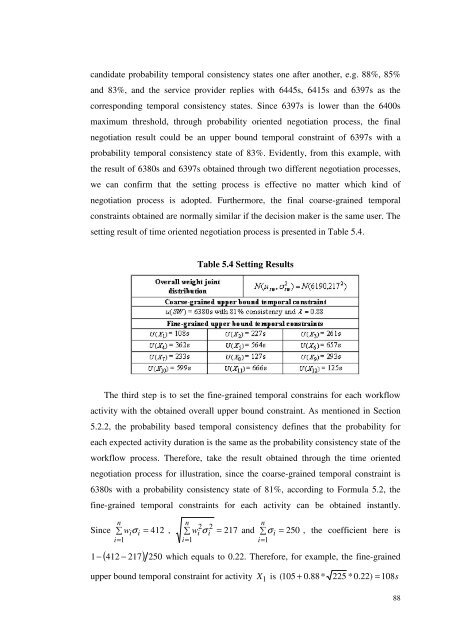Xiao Liu PhD Thesis.pdf - Faculty of Information and Communication ...
Xiao Liu PhD Thesis.pdf - Faculty of Information and Communication ...
Xiao Liu PhD Thesis.pdf - Faculty of Information and Communication ...
You also want an ePaper? Increase the reach of your titles
YUMPU automatically turns print PDFs into web optimized ePapers that Google loves.
c<strong>and</strong>idate probability temporal consistency states one after another, e.g. 88%, 85%<br />
<strong>and</strong> 83%, <strong>and</strong> the service provider replies with 6445s, 6415s <strong>and</strong> 6397s as the<br />
corresponding temporal consistency states. Since 6397s is lower than the 6400s<br />
maximum threshold, through probability oriented negotiation process, the final<br />
negotiation result could be an upper bound temporal constraint <strong>of</strong> 6397s with a<br />
probability temporal consistency state <strong>of</strong> 83%. Evidently, from this example, with<br />
the result <strong>of</strong> 6380s <strong>and</strong> 6397s obtained through two different negotiation processes,<br />
we can confirm that the setting process is effective no matter which kind <strong>of</strong><br />
negotiation process is adopted. Furthermore, the final coarse-grained temporal<br />
constraints obtained are normally similar if the decision maker is the same user. The<br />
setting result <strong>of</strong> time oriented negotiation process is presented in Table 5.4.<br />
Table 5.4 Setting Results<br />
The third step is to set the fine-grained temporal constrains for each workflow<br />
activity with the obtained overall upper bound constraint. As mentioned in Section<br />
5.2.2, the probability based temporal consistency defines that the probability for<br />
each expected activity duration is the same as the probability consistency state <strong>of</strong> the<br />
workflow process. Therefore, take the result obtained through the time oriented<br />
negotiation process for illustration, since the coarse-grained temporal constraint is<br />
6380s with a probability consistency state <strong>of</strong> 81%, according to Formula 5.2, the<br />
fine-grained temporal constraints for each activity can be obtained instantly.<br />
n<br />
n<br />
n<br />
2 2<br />
Since ∑ wiσ i = 412 , ∑ wi<br />
σ i = 217 <strong>and</strong> ∑σ<br />
i = 250<br />
i=<br />
1<br />
i=<br />
1<br />
i=<br />
1<br />
, the coefficient here is<br />
( 412 217) 250<br />
1− − which equals to 0.22. Therefore, for example, the fine-grained<br />
upper bound temporal constraint for activity X 1 is<br />
( 105 + 0.88* 225 *0.22) = 108s<br />
88
















